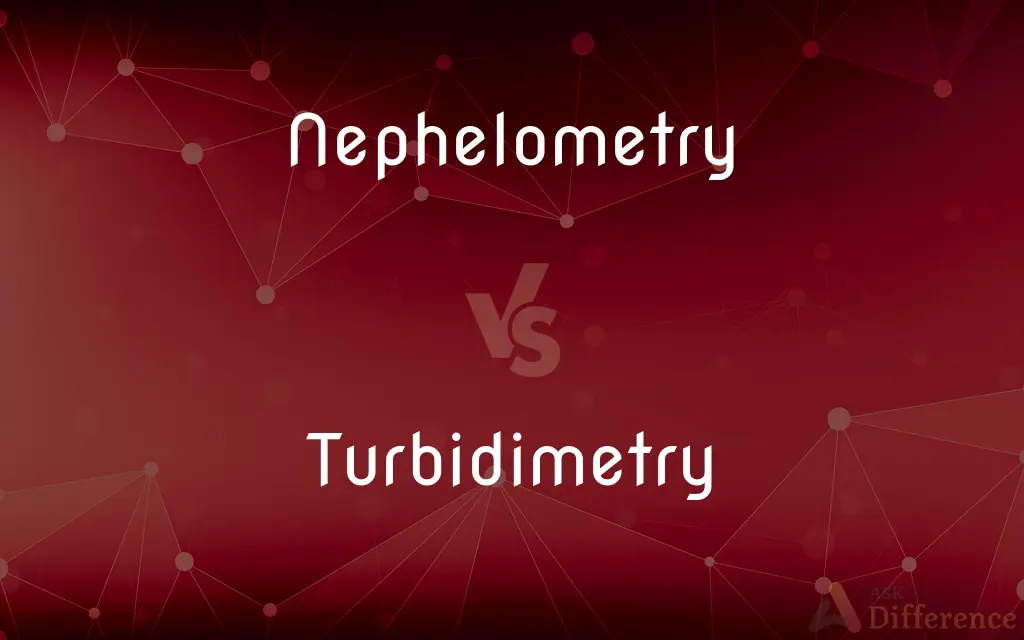Nephelometry vs. Turbidimetry — What's the Difference?
By Urooj Arif & Maham Liaqat — Updated on March 21, 2024
Nephelometry measures the intensity of scattered light at aangle to the light source to assess concentration of particulates in sample, while turbidimetry measures the reduction in light intensity transmitted through sample due to particle scattering.

Difference Between Nephelometry and Turbidimetry
Table of Contents
ADVERTISEMENT
Key Differences
Nephelometry relies on detecting light that is scattered by particles in a sample when illuminated. This technique is sensitive to changes in particle size, shape, and concentration, making it useful for analyzing solutions with low to moderate turbidity. The measurement is usually made at an angle to the incident light to optimize detection of scattered light. On the other hand, turbidimetry measures the decrease in the intensity of light transmitted directly through a sample. This method is most effective for samples with higher concentrations of particulates, where the reduction in transmitted light can be more accurately measured.
Both nephelometry and turbidimetry are employed for analyzing suspensions or solutions in various scientific fields, including biochemistry, environmental monitoring, and medicine. Nephelometry is particularly advantageous for detecting small particles or low concentrations, as the scattered light intensity can be highly sensitive to such conditions. Conversely, turbidimetry is straightforward and effective for samples where light passes through denser suspensions, as it measures the loss of light due to scattering and absorption by particles in the sample.
The choice between nephelometry and turbidimetry depends on the specific requirements of the analysis, including the expected range of particle concentrations and the nature of the particles themselves. Nephelometry can offer more sensitivity for diluted samples, while turbidimetry may provide more direct measurements for more turbid solutions.
In practice, nephelometric measurements often require calibration with standards of known turbidity because the intensity of scattered light can be influenced by various factors beyond particle concentration. Turbidimetry, while also requiring calibration, tends to be a more direct measure of turbidity but can be limited by high particle concentrations that result in very low light transmission.
Both methods contribute valuable tools in the analysis of particulate matter in solutions. By understanding the principles and applications of each, scientists and technicians can choose the most appropriate method for their specific analytical needs, whether monitoring environmental water quality, assessing the purity of pharmaceuticals, or conducting research in the life sciences.
ADVERTISEMENT
Comparison Chart
Principle
Measures scattered light at an angle.
Measures reduction in transmitted light.
Sensitivity
Higher sensitivity to small particles and low concentrations.
Better suited for higher concentrations of particulates.
Measurement Angle
At an angle to the incident light.
Directly in the path of the incident light.
Best Use
Low to moderate turbidity solutions.
Denser, more turbid samples.
Calibration
Requires calibration with known standards.
Also requires calibration, but directly measures turbidity.
Compare with Definitions
Nephelometry
A technique measuring scattered light intensity.
Nephelometry is used to quantify protein concentrations in laboratory samples.
Turbidimetry
Measures the decrease in light through a sample.
Turbidimetry evaluates water turbidity to ensure safety for consumption.
Nephelometry
Sensitive to particle size and concentration.
In water quality testing, nephelometry detects minute impurities.
Turbidimetry
Effective for dense particulate concentrations.
It's used in brewing to measure yeast cell concentration.
Nephelometry
Requires calibration with turbidity standards.
Calibration ensures nephelometry results are accurate and reliable.
Turbidimetry
Direct measurement of light transmission.
Turbidimeters measure how much light passes through to determine sample clarity.
Nephelometry
Useful in biochemistry and environmental science.
Nephelometry helps in assessing airborne particulate matter.
Turbidimetry
Calibration required for accurate measurement.
Using standards, turbidimetry can precisely assess sample turbidity.
Nephelometry
Involves angle-dependent light scattering.
The nephelometer collects light at 90 degrees to the source to analyze sample turbidity.
Turbidimetry
Applied in medical, environmental testing.
It's crucial in testing for contaminants in wastewater.
Nephelometry
An apparatus that is used to measure the size and concentration of particles in a liquid by analysis of light scattered by the liquid.
Turbidimetry
Turbidimetry (the name being derived from turbidity) is the process of measuring the loss of intensity of transmitted light due to the scattering effect of particles suspended in it. Light is passed through a filter creating a light of known wavelength which is then passed through a cuvette containing a solution.
Nephelometry
(analytical chemistry) The measurement of the concentration of a solution, suspension or dispersion based upon its light-scattering properties.
Turbidimetry
An instrument for measuring the loss in intensity of a light beam through a solution that contains suspended particulate matter.
Nephelometry
(immunology) A technique used to determine the levels of antibodies or antigens in a suspension, based on its light-scattering properties.
Turbidimetry
The measurement of turbidity by means of a turbidimeter
Common Curiosities
Can nephelometry and turbidimetry be used together?
Yes, combining both can provide a more comprehensive analysis of particle characteristics.
What determines the choice between nephelometry and turbidimetry?
The particle concentration and size, sample turbidity, and the specific analysis requirements.
How do environmental factors affect these measurements?
Temperature, sample handling, and the presence of colored or absorbing substances can influence measurements and require careful control.
How do calibration standards differ between the two methods?
Standards are designed to mimic the specific conditions measured by each method, reflecting either scattered or transmitted light properties.
Are nephelometry and turbidimetry limited to liquid samples?
While primarily used for liquids, adaptations exist for measuring particulates in gases and aerosols.
Can nephelometry be used to determine the type of particles in a sample?
While nephelometry excels at measuring particle concentration and size, it does not directly determine particle type, which may require additional analytical techniques.
How do temperature variations affect nephelometry and turbidimetry measurements?
Temperature can affect particle behavior and solvent properties, potentially influencing the scattering or absorption of light, and thus measurements should be conducted under controlled conditions.
What is the principle behind nephelometry?
Nephelometry measures the intensity of light scattered by particles in a sample at an angle relative to the incident light, indicating particle concentration and size.
Is specialized equipment required for nephelometry and turbidimetry?
Yes, both methods require specialized instruments called nephelometers and turbidimeters, respectively, designed to measure light scattering or transmission.
Are there any substances that can interfere with nephelometry or turbidimetry measurements?
Yes, substances that absorb light or have their own fluorescence can interfere with measurements, requiring sample preparation to minimize these effects.
How important is sample preparation in nephelometry and turbidimetry?
Proper sample preparation is crucial to remove interfering substances, ensure representative particle dispersion, and achieve accurate and reliable measurements.
How does turbidimetry differ from traditional transparency measurements?
Turbidimetry quantifies the reduction in light transmitted through a turbid sample, unlike transparency measurements which assess how clear a sample is by how much light passes through unaffected.
What types of samples are commonly analyzed with turbidimetry?
Common samples include water (for environmental monitoring), beverages (for clarity and quality control), and biological fluids (in medical diagnostics).
Can nephelometry detect color changes in a sample?
Nephelometry is not primarily used to detect color changes; it focuses on the scattering of light by particles, though drastic color changes might affect measurement visibility.
How do particle shape and size influence turbidimetry results?
Particle shape and size can significantly affect light scattering and absorption, influencing the turbidity measurement and necessitating calibration for accurate assessments.
Share Your Discovery

Previous Comparison
Easement vs. Covenant
Next Comparison
Kevlar vs. TeflonAuthor Spotlight
Written by
Urooj ArifUrooj is a skilled content writer at Ask Difference, known for her exceptional ability to simplify complex topics into engaging and informative content. With a passion for research and a flair for clear, concise writing, she consistently delivers articles that resonate with our diverse audience.
Co-written by
Maham Liaqat















































